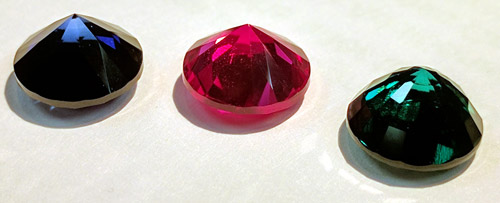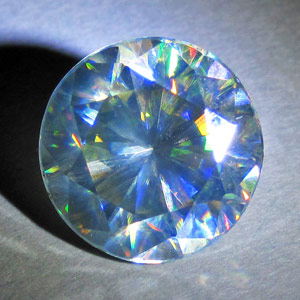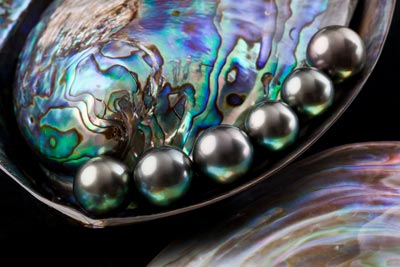Gemstone Types
Natural
Natural gemstones are minerals or rocks formed through geological processes, reflecting the Earth's history. They originate in various regions within the Earth's crust and mantle, undergoing distinct geological processes.
Quartz crystals are formed in the Earth's crust and are composed of silicon and oxygen and often originate in pegmatite veins or sedimentary environments. Over time, these crystals develop into stunning varieties like Amethyst and Citrine, each displaying unique coloration based on the presence of trace elements during their formation.
Peridot, a variety of Olivine, forms in the Earth's mantle. It is born from the intense heat and pressure found deep within the Earth. Peridot crystals are created during volcanic eruptions, as molten rock containing the mineral Olivine rises to the surface. These green gemstones are found in basalt rocks, created as a result of these volcanic processes.

Synthetic
Synthetic gemstones are laboratory-grown replicas of natural gems, carefully designed to mimic their physical and optical properties. These gems are produced through a variety of methods, each tailored to specific gem types. Three common methods include the Verneuil (flame fusion) process, the Czochralski method, and the hydrothermal process.
The Verneuil process involves melting powdered material with a chemical composition similar to the target gemstone. This molten material is then allowed to cool, forming a synthetic crystal. One example of gemstones created using the Verneuil process is synthetic corundum, which includes sapphires and rubies. Synthetic sapphires and rubies produced through this method closely resemble their natural counterparts in appearance and chemical composition. These synthetic gems are virtually indistinguishable from natural ones and are often used in jewellery.
The Czochralski method is a crystal growth technique where a seed crystal is dipped into a melt of the same material. As the seed is slowly pulled out and rotated, it collects the material, allowing a synthetic crystal to grow. An example of gemstones produced using the Czochralski method is synthetic Alexandrite, a variety of Chrysoberyl. Synthetic Alexandrite is created by using a melt that contains the elements found in natural alexandrite, such as beryllium, aluminium, and chromium. This method ensures that the synthetic alexandrite closely replicates the colour-changing properties and visual appeal of natural Alexandrite.
The hydrothermal method is used to grow synthetic gem crystals in an aqueous solution at high pressure and temperature. A common example of gemstones produced through this method is synthetic emerald. In the hydrothermal process, a seed crystal is placed in a solution rich in elements found in natural emeralds, such as beryl. Over time, as the solution is heated and pressurized, emerald crystals form around the seed crystal. Synthetic Emeralds, a variety of Beryl, created through this process are virtually indistinguishable from their natural counterparts and can display the characteristic green colour and inclusions typical of Emeralds.
These synthetic gemstones offer a sustainable and often more affordable alternative to their natural counterparts while maintaining their visual appeal and physical properties. They have gained popularity and are commonly used in various jewellery pieces.

Simulant
Simulant gemstones are materials that imitate the visual qualities of natural gemstones but do not share the same chemical composition. A well-known example is Cubic Zirconia, which closely replicates the brilliance and sparkle of diamonds. Cubic Zirconia is made from zirconium dioxide, unlike natural diamonds, which consist of carbon atoms arranged in a crystal lattice structure.
Glass is another common simulant used to replicate various gemstones, including turquoise. When used for this purpose, glass is chosen for its ability to mimic the colour and transparency of the original gemstone, even though it lacks the geological origin and composition of the natural counterpart.
Composite
Composite gemstones belong to a category that combines natural and synthetic elements to enhance both their visual appeal and durability. These gems strike a balance between aesthetics and robustness, offering an appealing alternative to fully natural or synthetic gemstones.
A classic example of a composite gemstone is composite Turquoise. It is crafted by binding small fragments of real Turquoise with a resilient resin. The composite retains the vibrant blue and green colours of natural Turquoise while gaining strength and resilience, making it ideal for enduring daily wear.
Doublet composites comprise two distinct layers. An example is the doublet Opal, which involves attaching a delicate slice of natural Opal to a solid backing material. This combination enhances the Opal's play-of-colour, highlighting its mesmerizing iridescence. By blending the natural Opal's beauty with the sturdy backing, doublet opals offer both visual appeal and durability.
Triplet gemstones expand on the composite concept by introducing a transparent capping layer. An example of a triplet gemstone is a triplet Garnet in which a genuine Garnet cabochon is positioned atop a dark backing material, with a clear Quartz capping layer. This three-layer construction serves to intensify the Garnet's deep red colour and lustre while increasing its size. Triplet gemstones combine aesthetic charm with resilience for enduring beauty.
Organic
Organic gemstones are unique as they originate from living organisms. Pearls, such as those produced by oysters and mussels, form within the shells due to a biological process. When an irritant, like a grain of sand, enters the mollusc, it secretes layers of nacre, resulting in the lustrous and iridescent pearl. Corals are another organic gemstone, formed by colonies of marine animals known as polyps. Over time, their skeletons accumulate, creating the Coral's distinctive appearance.
Amber is another organic gemstone, created from fossilized tree resin. This resin traps prehistoric insects and plant material, which become preserved over millions of years. Organic gemstones like these are valued not only for their beauty but also for their biological and historical significance, as they provide a tangible link to the natural world and Earth's history.
